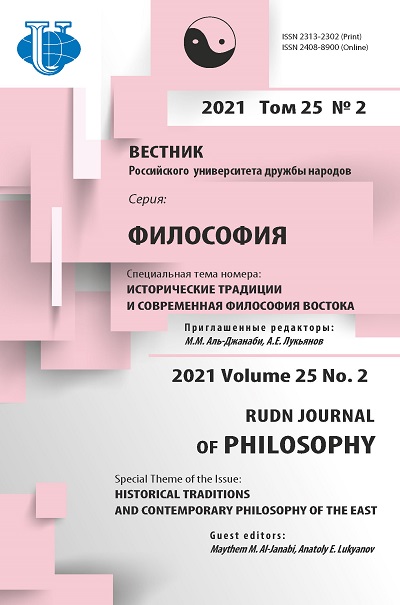Conception of Harmonious Union: Philosophy History Aspect
- Authors: Majorow W.M.1
-
Affiliations:
- Institute of Far Eastern Studies RAS
- Issue: Vol 25, No 2 (2021): HISTORICAL TRADITIONS AND CONTEMPORARY PHILOSOPHY OF THE EAST
- Pages: 288-297
- Section: HISTORICAL TRADITIONS AND CONTEMPORARY PHILOSOPHY OF THE EAST
- URL: https://journals.rudn.ru/philosophy/article/view/26671
- DOI: https://doi.org/10.22363/2313-2302-2021-25-2-288-297
Cite item
Full Text
Abstract
The academic and humanitarian conception of harmonious union (hehe) has been proposed by Professor Zhang Liwen in the 1990s. It claims to explain the specifics of Chinese civilization and proposes solution of some global problems by its means. Despite the lack of direct references to the conception, it remains in demand both in the political and ideological discourse of the People's Republic of China. This presentations deals with the historical and philosophical facts available in Chinese written monuments and works of Antiquity and the Middle Ages, which are put forward as a justification for the primordial idea of ‘harmonious union’ in Chinese culture. An attempt is done to show that this concept does not offer any new set of philosophical categories, but appeals to the well-known concepts of two-, three- and five-item classifications. At the same time, the emphasis is laid on the form, the method of combining opposite or dissimilar elements. In general, on the basis of the limited historical and philosophical material, it can be concluded that the concept of harmonious unification is aimed not so much at revising the composition of the philosophical system of Confucianism, but at rethinking its value criteria for interaction and mutual dependence of objects and phenomena.
Keywords
About the authors
Wladimir M. Majorow
Institute of Far Eastern Studies RAS
Author for correspondence.
Email: v.mayorov@mail.ru
Candidate of Science (History), Professor
32, Nakhimovsky Av., Moscow, 117997, Russian FederationReferences
- Xi Jinping zai Yazhou wenming duihua dahui kaimushi shang de zhuzhi yanjiang (quanwen). URL: http://politics.people.com.cn/n1/2019/0515/c1024-31086589.html [Accessed 15th December 2020]. (In Chinese).
- Xi Jinping spoke at the opening ceremony of Asian civilization dialogue conference. URL: http://russian.news.cn/2019-05/15/c_138061342.htm [Accessed 15th December 2020]. (In Russian).
- Yang Shu. «Hehe» thought and civilizational exchange in mutual reflexing. URL: http://theory.people.com.cn/n1/2019/0611/c40531-31128648.html [Accessed 15th December 2020]. (In Chinese).
- Taiwan founds the Harmonious union cultural party. URL: https://www.youtube.com/watch?v=-kdUsBVqFKk [Accessed 15th December 2020].
- Confucian Four Books (Si shu). Ed. by LS Perelomov. Tr. by AI Kobzev. Moscow: Vostochnaya literature; 2004. 431 p. (In Russian).
- Yurkevich A, Perelomov LS. Confucianism and PRC current strategic course. Far Eastern Affairs. 2008;(3):176—180. (In Russian).
- Spiritual culture of China: Encyclopedia. Vol. 4. Historical thought. Political and juridical culture. Moscow: Vostochnaya literatura; 2009. 935 p. (In Russian).
- Shuo wen jie zi. URL: https://ctext.org/shuo-wen-jie-zi/kou-bu/zh [Accessed 15th December 2020]. (In Chinese).
- Guo yu. URL: https://ctext.org/guo-yu/zh [Accessed 15th December 2020]. (In Chinese).
- Guo yu (Speeches of States). Tr. by VS Taskin. Moscow: Nauka, Vostochnaya literature; 1987. 472 p. (In Russian).
- Yanzi Chunqiu jishi. URL: https://ctext.org/wiki.pl?if=gb&res=262915 [Accessed 15th December 2020]. (In Chinese).
- Zhuangzi. URL: https://ctext.org/zhuangzi/ens [Accessed 15th December 2020]. (In Chinese).
- Zhunagzi. Liezi. Tr. by VV. Malyavin. Moscow: Mysl’, 1995. 439 p. (In Russian).
- Esteemed Book: Ancient Chinese Texts and Translations of Shang shu (Shu jing) and The Shorter Preface (Shu xu). Tr. by VM Mayorov; Preface by VM Mayorov and LV Stezhenskaya. Moscow; 2014. 1149 p. (In Russian).
- Liji. URL: https://ctext.org/liji/ens [Accessed 15th December 2020]. (In Chinese).
- Yi jing (The Bookof Changes). Tr. by AE Lukyanov. Moscow: MASKA; Chengdu: Sichuan renminchubanshe; 2018. 392 p. (In Russian).
- Huainanzi. https://ctext.org/huainanzi/ens [Accessed 15th December 2020]. (In Chinese).
- Philosophers from Huainan — Huainanazi. Tr. by LE Pomerantsev. Moscow: Mysl’, 2004. 430 p. (In Russian).
- Dao de jing [Text]: A Reader. Tr. by AE Lukyanov et. al. Moscow: IDV RAN, 2016. 346 p.
















